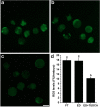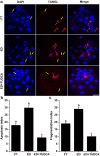Tauroursodeoxycholic acid enhances the development of porcine embryos derived from in vitro-matured oocytes and evaporatively dried spermatozoa
- PMID: 28754923
- PMCID: PMC5533721
- DOI: 10.1038/s41598-017-07185-w
Tauroursodeoxycholic acid enhances the development of porcine embryos derived from in vitro-matured oocytes and evaporatively dried spermatozoa
Abstract
Evaporative drying (ED) is an alternative technique for long-term preservation of mammalian sperm, which does not require liquid nitrogen or freeze-drying equipment, but offers advantages for storage and shipping at ambient temperature and low cost. However, the development of zygotes generated from these sperms was poor. Here, we demonstrated that the supplementation of tauroursodeoxycholic acid (TUDCA), an endogenous bile acid, during embryo culture improved the developmental competency of embryos derived from in vitro matured pig oocytes injected intracytoplasmically with boar ED spermatozoa by reducing the production of reactive oxygen species, the DNA degradation and fragmentation, and the expression of apoptosis-related gene Bax and Bak, and by increasing the transcription of anti-apoptosis gene Bcl-XL and Bcl-2. Furthermore, TUDCA treatment promoted the blastocyst quality manifested by the total cell numbers and the ratio of inner cell mass. Taken together, our data suggest that evaporative drying would be a potentially useful method for the routine preservation of boar sperm in combination with further optimization of subsequently embryo culture conditions.
Conflict of interest statement
The authors declare that they have no competing interests.
Figures



Similar articles
-
Tauroursodeoxycholic acid (TUDCA) enhanced intracytoplasmic sperm injection (ICSI) embryo developmental competence by ameliorating endoplasmic reticulum (ER) stress and inhibiting apoptosis.J Assist Reprod Genet. 2020 Jan;37(1):119-126. doi: 10.1007/s10815-019-01627-2. Epub 2019 Dec 4. J Assist Reprod Genet. 2020. PMID: 31802346 Free PMC article.
-
Tauroursodeoxycholic acid enhances the pre-implantation embryo development by reducing apoptosis in pigs.Reprod Domest Anim. 2012 Oct;47(5):791-8. doi: 10.1111/j.1439-0531.2011.01969.x. Epub 2011 Dec 13. Reprod Domest Anim. 2012. PMID: 22151574
-
Leptin and nonessential amino acids enhance porcine preimplantation embryo development in vitro by intracytoplasmic sperm injection.Theriogenology. 2013 Jan 15;79(2):291-8. doi: 10.1016/j.theriogenology.2012.08.019. Epub 2012 Nov 20. Theriogenology. 2013. PMID: 23174770
-
Current status of freeze-drying technology to preserve domestic animals sperm.Reprod Domest Anim. 2014 Oct;49 Suppl 4:72-81. doi: 10.1111/rda.12396. Reprod Domest Anim. 2014. PMID: 25277435 Review.
-
In vitro production of pig embryos: a point of view.Reprod Fertil Dev. 2002;14(5-6):275-86. doi: 10.1071/rd01102. Reprod Fertil Dev. 2002. PMID: 12467351 Review.
Cited by
-
Assessing the tolerance to room temperature and viability of freeze-dried mice spermatozoa over long-term storage at room temperature under vacuum.Sci Rep. 2018 Jul 13;8(1):10602. doi: 10.1038/s41598-018-28896-8. Sci Rep. 2018. PMID: 30006561 Free PMC article.
-
Tauroursodeoxycholic acid (TUDCA) enhanced intracytoplasmic sperm injection (ICSI) embryo developmental competence by ameliorating endoplasmic reticulum (ER) stress and inhibiting apoptosis.J Assist Reprod Genet. 2020 Jan;37(1):119-126. doi: 10.1007/s10815-019-01627-2. Epub 2019 Dec 4. J Assist Reprod Genet. 2020. PMID: 31802346 Free PMC article.
-
Tauroursodeoxycholic Acid Enhances the Quality of Postovulatory Aged Oocytes by Alleviating Oxidative Stress, Apoptosis, and Endoplasmic Reticulum Stress in Pigs.Vet Sci. 2025 Mar 12;12(3):265. doi: 10.3390/vetsci12030265. Vet Sci. 2025. PMID: 40266976 Free PMC article.
References
Publication types
MeSH terms
Substances
LinkOut - more resources
Full Text Sources
Other Literature Sources
Research Materials

